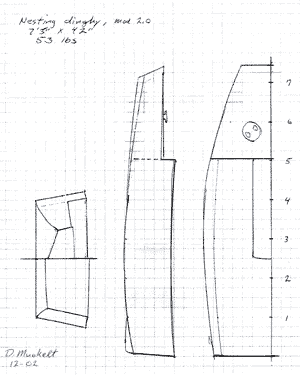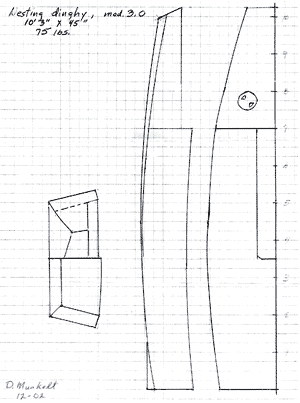Entry 1
Nesting Dinghy 2.0, 3.0
Dana Munkelt
|
|
| Judge's comments:
Dana gave us some original thinking with his removable
bouyancy tank with lower freeboard than the rest of
his design. This really is a most useful little boat...
Dana has, rather than design a break apart boat,
produced a boat that is complete in itself, watertight
and structurally complete, but with an extension bolted
to the forward end that adds length and streamlines
the load carrying blunt ended punt. Being closed in,
it contributes to the boat's buoyancy if swamped and
if fitted with a hatch would be a useful dry storage
place for a picnic lunch and spare warm clothing.
The shape is a little reminiscent of the Auray fishermans
punt, legendary for its seaworthiness which is a good
omen, the bigger version is big enough to carry the
anticipated load well and she will both row and power
very well.
It’s a good interpretation of the brief, will
be a good boat, and I’m looking forward to seeing
the results of someone building her.
|
First I must give credit
to Thomas Firth Jones, in whose book “Multihull Voyaging”
there is a nesting dinghy which was my starting point. The difference
from other take-apart dinghys I have seen is that the bow section
is not for payload, so need not have full freeboard. This makes
it smaller and easier to stow, and when decked, it makes a great
buoyancy tank and waterline extender.
Nesting Dinghy
Model 2.0 at 7’5” assembled (5’ when
nested) was built last year of 3/16 luan ply and glass tape
in about 50 hours, and works very well with one to two aboard,
thank you. It fits inside my station wagon, or the bed of a
small pickup, and stands politely on it’s transom in the
corner between trips, not leaning on the wall (nice for an apt.).
At 53 lbs. it’s easy to lift, but I’m working on
a dolly to strap on a corner of the transom and wheel it away
like a handtruck.
You may notice the absence
of a stern seat, and I have a fiendishly clever plan: there
are two eyestraps on the floor about 8” forward of the
transom and 17” apart. A stap runs between them, and two
or three normal float cushions can be held by it to make a comfy
USCG compliant seat. A good sized cooler or tackle box would
fit there also. The eyestraps are backed up by twin skegs which
help the boat sit level on the beach, and when the bow is lifted
only the skegs will touch as it’s dragged across the sand.
The mating bulkheads were made in advance, and are connected
by a pair of bolts to “tee nuts” anchored in the
bow section. The bolts have cast epoxy knobs for hand tightening.

Nesting Dinghy 2.0 lines (click to enlarge)
Nesting dinghy
3.0, at 10’3” assembled and 7’ nested.
The configuration is the same with a low bow section decked
for buoyancy. Quite a bit more boat at 75 lbs., and if sailing
will need three fastening bolts in a triangle. Shrouds would
help take some of the torque off the joint as well. This one
will have a payload of over 400 lbs., can row, sail or power,
and will need the transom dolly to roll around on.

Nesting Dinghy 2.0 lines (click to enlarge)
Bio
Dana Munkelt has built a few
boats since helping with his Dad’s skiff (It’s all
Dad’s fault!) a few decades ago. The skiff is still fishing
50 miles out on the Big Ocean, and the other boats include a
couple aerolight canoes, 3 prams, a dinghy, a Searunner 32’
catamaran… He also enjoyed developing the rules for this
contest.
Mr. Munkelt resides at
the homeport of the USN’s Pacific Fleet, and makes a living
at production control and purchasing when layoffs aren’t
happening. He also enjoys gardening, reading, and cycling, and
thanks the Big Guy for giving him the chance to do so many things.



